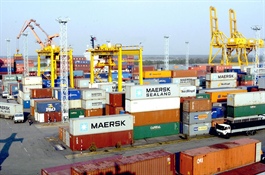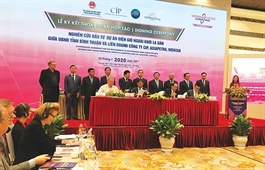Viet Nam gains $6.5b trade surplus in 7 months
Viet Nam gains $6.5b trade surplus in 7 months
Viet Nam achieved a trade surplus of US$6.5 billion in the first seven months of this year, including $1 billion in July, according to the General Statistics Office (GSO).

The foreign-invested sector, including crude oil, recorded a trade surplus of $17.6 billion, the office said. However, the domestic economic sector had a trade deficit of $11.1 billion.
The office also noted that in the first seven months, the export value was estimated at $145.79 billion, up 0.2 per cent over the same period last year.
Of which, the domestic economic sector continued to be the highlight with export value at $50.76 billion, up 13.5 per cent while the foreign-invested sector reached $95.03 billion, accounting for 65.2 per cent of total export value, down 5.7 per cent year on year.
In July, the total export value was estimated at $23 billion, up 1.9 per cent compared to last month. Of which, $8.5 billion was from the domestic economic sector, up 2.6 per cent month-on-month and $14.5 billion from the foreign-invested sector, up 1.5 per cent.
During the first seven months, 23 goods saw an export value of over $1 billion. Of which, the group of phones and components had the highest export value with $25.7 billion, but it fell by 6.6 per cent over the same period last year.
The group of electronics, computers, and components followed with $23.1 billion, up 24.3 per cent, tagged along by textiles and garments with $16.2 billion, down 12.1 per cent.
The group of machinery, equipment, and spare parts had an export value of $12.4 billion, up 27.1 per cent, and footwear with $9.5 billion, down 7.9 per cent.
Exports of most agricultural products decreased compared to the same period last year, including fruit, vegetables, coffee, cashew, rubber and pepper. Only rice products gained a growth of 10.9 per cent in export value to $1.9 billion.
The US was Viet Nam's largest export market in the first seven months of this year with a value of $37.9 billion, up 15 per cent year on year. Other large export markets included China, EU, ASEAN, Japan and South Korea.
Meanwhile, China was Viet Nam's largest import market with an estimated value of $41.6 billion, down 1.8 per cent year on year.
In the first seven months, the national import value was estimated at $139.33 billion, down by 2.9 per cent compared to the same period last year. The import value was $61.86 billion from the domestic economic sector, up by 1.5 per cent and $77.47 billion from the foreign-invested sector, down by 6.2 per cent.
The Import-Export Department (Ministry of Industry and Trade) said Viet Nam's import and export of goods is expected to be better in the second half of this year because many countries have started easing disease control measures and opening markets to accelerate economic recovery.
In the second half of this year, the department expects the implementation of the EU-Vietnam Free Trade Agreement (EVFTA) to create more export opportunities for Viet Nam to the world's second largest market with a population of over 508 million people and a $18-trillion GDP.
However, the department also said that Viet Nam's trade activities would continue to face unpredictable factors because the disease is not controlled completely. Therefore, the country would face difficulties in achieving growth in export value as in previous years.
Next year, the national export value is forecasted to depend on the control of the pandemic and re-opening of the world economy, according to the Import and Export Department.
The Ministry of Industry and Trade would continue to implement measures to remove difficulties and boost production and export, it said.
The ministry has proposed to the Government many solutions not only to remove difficulties for trade and export but also to maintain efficient production, reported chinhphu.vn.
Of which, the ministry has put into operation a website on the EVFTA at http://evfta.moit.gov.vn/ to help individuals and businesses study issues relating to the EVFTA including an overview of the deal, this FTA's commitments in key areas such as goods, services – investment and useful information for exporters.
In addition, the ministry has applied information technology to reform administrative procedures boosting exports.
At present, there are six online administrative procedures in the import and export fields to connect to the National Single Window system while 11 other administrative procedures are carried out entirely online at level 4.
























